Strategic Management: Tesco's CEO and Business Performance Enhancement
VerifiedAdded on 2023/06/16
|12
|3762
|356
Report
AI Summary
This report examines the management styles and strategic techniques employed by the CEO of Tesco to enhance business performance. It begins by analyzing the business and corporate strategies, such as cost leadership, differentiation, expansion, and retrenchment, that contribute positively to Tesco's success. The report then delves into internal and external environment analysis using SWOT, addressing challenges like low operational performance and Brexit implications. Strategic techniques, including Porter's Five Forces, are described, highlighting bargaining power, competitive rivalry, and threats of substitution. The strategic planning process, involving mission identification, situation analysis, objective setting, strategy development, and evaluation planning, is also examined. Finally, the report evaluates contemporary strategic issues at functional, business, and cooperative levels, such as marketing strategies, cost leadership challenges, and stakeholder management. The report concludes with recommendations for continued improvement and success.
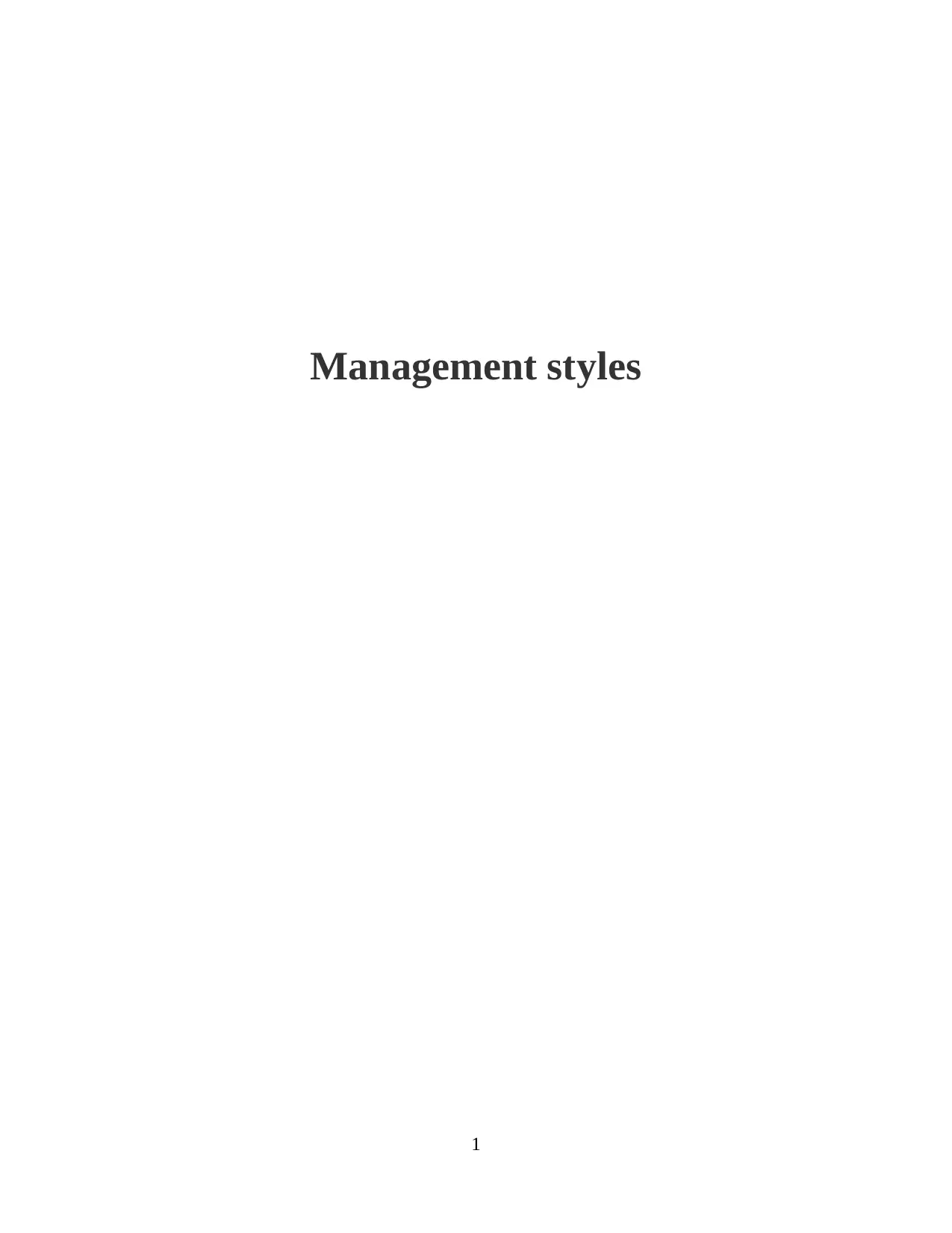
Management styles
1
1
Paraphrase This Document
Need a fresh take? Get an instant paraphrase of this document with our AI Paraphraser
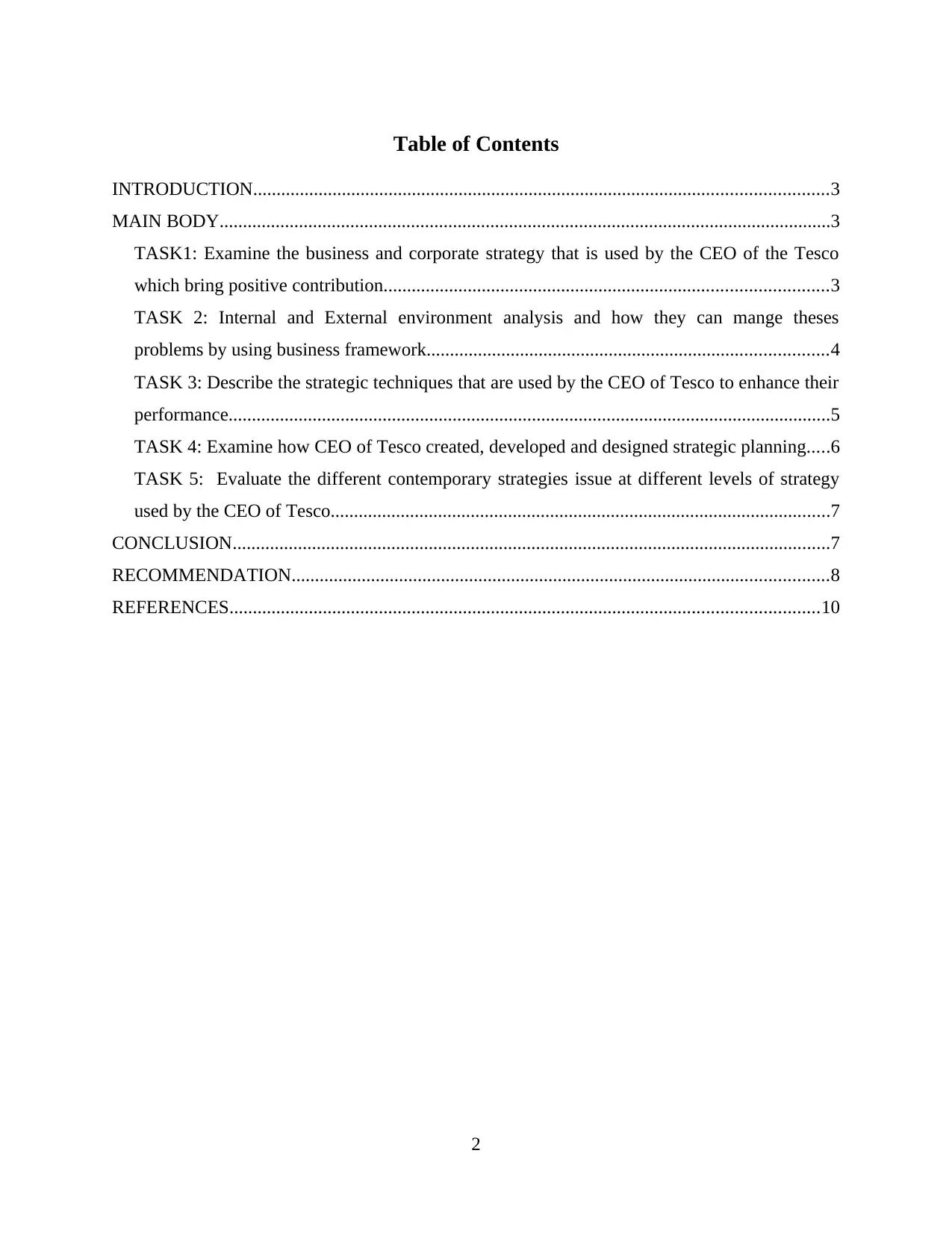
Table of Contents
INTRODUCTION...........................................................................................................................3
MAIN BODY...................................................................................................................................3
TASK1: Examine the business and corporate strategy that is used by the CEO of the Tesco
which bring positive contribution...............................................................................................3
TASK 2: Internal and External environment analysis and how they can mange theses
problems by using business framework......................................................................................4
TASK 3: Describe the strategic techniques that are used by the CEO of Tesco to enhance their
performance.................................................................................................................................5
TASK 4: Examine how CEO of Tesco created, developed and designed strategic planning.....6
TASK 5: Evaluate the different contemporary strategies issue at different levels of strategy
used by the CEO of Tesco...........................................................................................................7
CONCLUSION................................................................................................................................7
RECOMMENDATION...................................................................................................................8
REFERENCES..............................................................................................................................10
2
INTRODUCTION...........................................................................................................................3
MAIN BODY...................................................................................................................................3
TASK1: Examine the business and corporate strategy that is used by the CEO of the Tesco
which bring positive contribution...............................................................................................3
TASK 2: Internal and External environment analysis and how they can mange theses
problems by using business framework......................................................................................4
TASK 3: Describe the strategic techniques that are used by the CEO of Tesco to enhance their
performance.................................................................................................................................5
TASK 4: Examine how CEO of Tesco created, developed and designed strategic planning.....6
TASK 5: Evaluate the different contemporary strategies issue at different levels of strategy
used by the CEO of Tesco...........................................................................................................7
CONCLUSION................................................................................................................................7
RECOMMENDATION...................................................................................................................8
REFERENCES..............................................................................................................................10
2
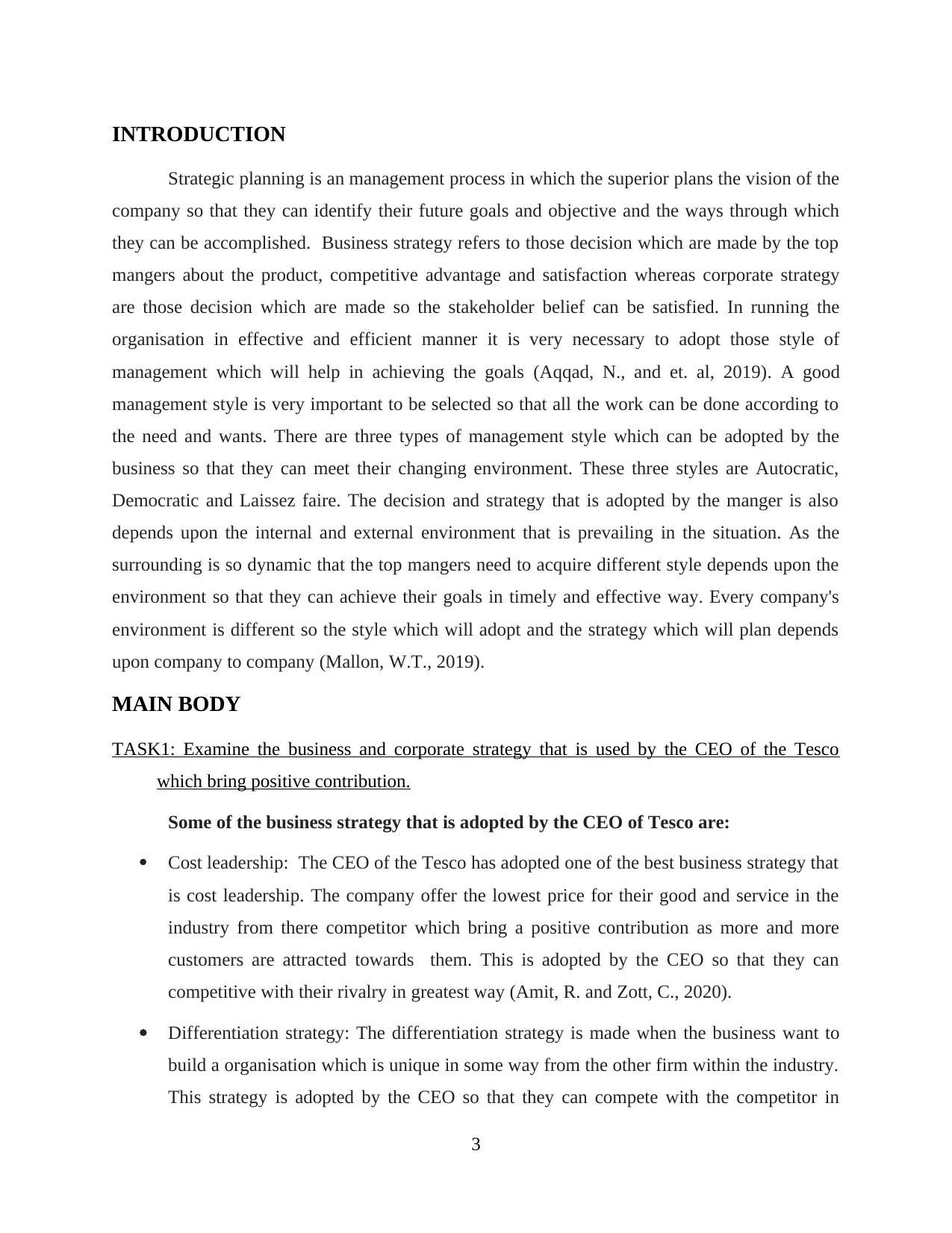
INTRODUCTION
Strategic planning is an management process in which the superior plans the vision of the
company so that they can identify their future goals and objective and the ways through which
they can be accomplished. Business strategy refers to those decision which are made by the top
mangers about the product, competitive advantage and satisfaction whereas corporate strategy
are those decision which are made so the stakeholder belief can be satisfied. In running the
organisation in effective and efficient manner it is very necessary to adopt those style of
management which will help in achieving the goals (Aqqad, N., and et. al, 2019). A good
management style is very important to be selected so that all the work can be done according to
the need and wants. There are three types of management style which can be adopted by the
business so that they can meet their changing environment. These three styles are Autocratic,
Democratic and Laissez faire. The decision and strategy that is adopted by the manger is also
depends upon the internal and external environment that is prevailing in the situation. As the
surrounding is so dynamic that the top mangers need to acquire different style depends upon the
environment so that they can achieve their goals in timely and effective way. Every company's
environment is different so the style which will adopt and the strategy which will plan depends
upon company to company (Mallon, W.T., 2019).
MAIN BODY
TASK1: Examine the business and corporate strategy that is used by the CEO of the Tesco
which bring positive contribution.
Some of the business strategy that is adopted by the CEO of Tesco are:
Cost leadership: The CEO of the Tesco has adopted one of the best business strategy that
is cost leadership. The company offer the lowest price for their good and service in the
industry from there competitor which bring a positive contribution as more and more
customers are attracted towards them. This is adopted by the CEO so that they can
competitive with their rivalry in greatest way (Amit, R. and Zott, C., 2020).
Differentiation strategy: The differentiation strategy is made when the business want to
build a organisation which is unique in some way from the other firm within the industry.
This strategy is adopted by the CEO so that they can compete with the competitor in
3
Strategic planning is an management process in which the superior plans the vision of the
company so that they can identify their future goals and objective and the ways through which
they can be accomplished. Business strategy refers to those decision which are made by the top
mangers about the product, competitive advantage and satisfaction whereas corporate strategy
are those decision which are made so the stakeholder belief can be satisfied. In running the
organisation in effective and efficient manner it is very necessary to adopt those style of
management which will help in achieving the goals (Aqqad, N., and et. al, 2019). A good
management style is very important to be selected so that all the work can be done according to
the need and wants. There are three types of management style which can be adopted by the
business so that they can meet their changing environment. These three styles are Autocratic,
Democratic and Laissez faire. The decision and strategy that is adopted by the manger is also
depends upon the internal and external environment that is prevailing in the situation. As the
surrounding is so dynamic that the top mangers need to acquire different style depends upon the
environment so that they can achieve their goals in timely and effective way. Every company's
environment is different so the style which will adopt and the strategy which will plan depends
upon company to company (Mallon, W.T., 2019).
MAIN BODY
TASK1: Examine the business and corporate strategy that is used by the CEO of the Tesco
which bring positive contribution.
Some of the business strategy that is adopted by the CEO of Tesco are:
Cost leadership: The CEO of the Tesco has adopted one of the best business strategy that
is cost leadership. The company offer the lowest price for their good and service in the
industry from there competitor which bring a positive contribution as more and more
customers are attracted towards them. This is adopted by the CEO so that they can
competitive with their rivalry in greatest way (Amit, R. and Zott, C., 2020).
Differentiation strategy: The differentiation strategy is made when the business want to
build a organisation which is unique in some way from the other firm within the industry.
This strategy is adopted by the CEO so that they can compete with the competitor in
3
⊘ This is a preview!⊘
Do you want full access?
Subscribe today to unlock all pages.

Trusted by 1+ million students worldwide
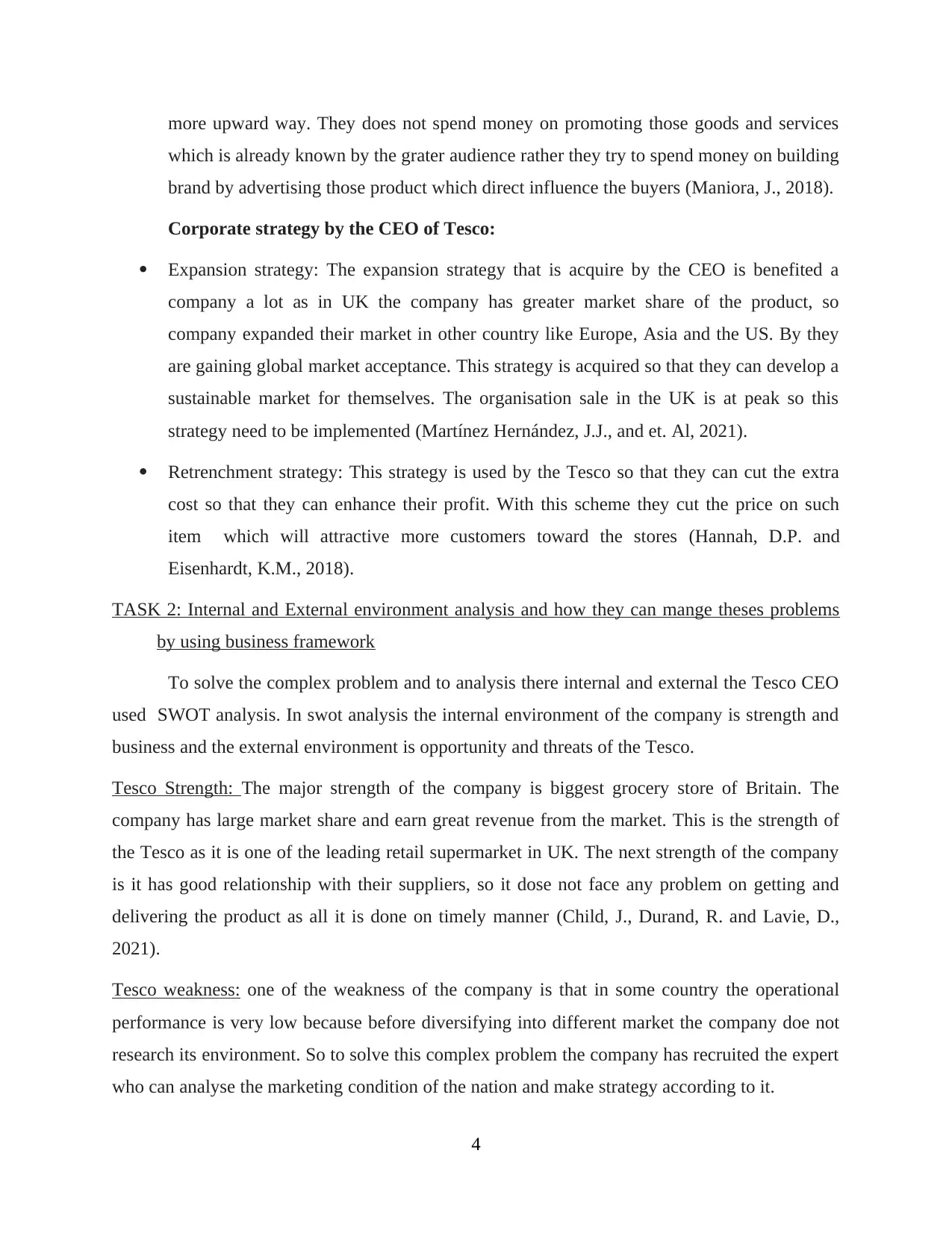
more upward way. They does not spend money on promoting those goods and services
which is already known by the grater audience rather they try to spend money on building
brand by advertising those product which direct influence the buyers (Maniora, J., 2018).
Corporate strategy by the CEO of Tesco:
Expansion strategy: The expansion strategy that is acquire by the CEO is benefited a
company a lot as in UK the company has greater market share of the product, so
company expanded their market in other country like Europe, Asia and the US. By they
are gaining global market acceptance. This strategy is acquired so that they can develop a
sustainable market for themselves. The organisation sale in the UK is at peak so this
strategy need to be implemented (Martínez Hernández, J.J., and et. Al, 2021).
Retrenchment strategy: This strategy is used by the Tesco so that they can cut the extra
cost so that they can enhance their profit. With this scheme they cut the price on such
item which will attractive more customers toward the stores (Hannah, D.P. and
Eisenhardt, K.M., 2018).
TASK 2: Internal and External environment analysis and how they can mange theses problems
by using business framework
To solve the complex problem and to analysis there internal and external the Tesco CEO
used SWOT analysis. In swot analysis the internal environment of the company is strength and
business and the external environment is opportunity and threats of the Tesco.
Tesco Strength: The major strength of the company is biggest grocery store of Britain. The
company has large market share and earn great revenue from the market. This is the strength of
the Tesco as it is one of the leading retail supermarket in UK. The next strength of the company
is it has good relationship with their suppliers, so it dose not face any problem on getting and
delivering the product as all it is done on timely manner (Child, J., Durand, R. and Lavie, D.,
2021).
Tesco weakness: one of the weakness of the company is that in some country the operational
performance is very low because before diversifying into different market the company doe not
research its environment. So to solve this complex problem the company has recruited the expert
who can analyse the marketing condition of the nation and make strategy according to it.
4
which is already known by the grater audience rather they try to spend money on building
brand by advertising those product which direct influence the buyers (Maniora, J., 2018).
Corporate strategy by the CEO of Tesco:
Expansion strategy: The expansion strategy that is acquire by the CEO is benefited a
company a lot as in UK the company has greater market share of the product, so
company expanded their market in other country like Europe, Asia and the US. By they
are gaining global market acceptance. This strategy is acquired so that they can develop a
sustainable market for themselves. The organisation sale in the UK is at peak so this
strategy need to be implemented (Martínez Hernández, J.J., and et. Al, 2021).
Retrenchment strategy: This strategy is used by the Tesco so that they can cut the extra
cost so that they can enhance their profit. With this scheme they cut the price on such
item which will attractive more customers toward the stores (Hannah, D.P. and
Eisenhardt, K.M., 2018).
TASK 2: Internal and External environment analysis and how they can mange theses problems
by using business framework
To solve the complex problem and to analysis there internal and external the Tesco CEO
used SWOT analysis. In swot analysis the internal environment of the company is strength and
business and the external environment is opportunity and threats of the Tesco.
Tesco Strength: The major strength of the company is biggest grocery store of Britain. The
company has large market share and earn great revenue from the market. This is the strength of
the Tesco as it is one of the leading retail supermarket in UK. The next strength of the company
is it has good relationship with their suppliers, so it dose not face any problem on getting and
delivering the product as all it is done on timely manner (Child, J., Durand, R. and Lavie, D.,
2021).
Tesco weakness: one of the weakness of the company is that in some country the operational
performance is very low because before diversifying into different market the company doe not
research its environment. So to solve this complex problem the company has recruited the expert
who can analyse the marketing condition of the nation and make strategy according to it.
4
Paraphrase This Document
Need a fresh take? Get an instant paraphrase of this document with our AI Paraphraser
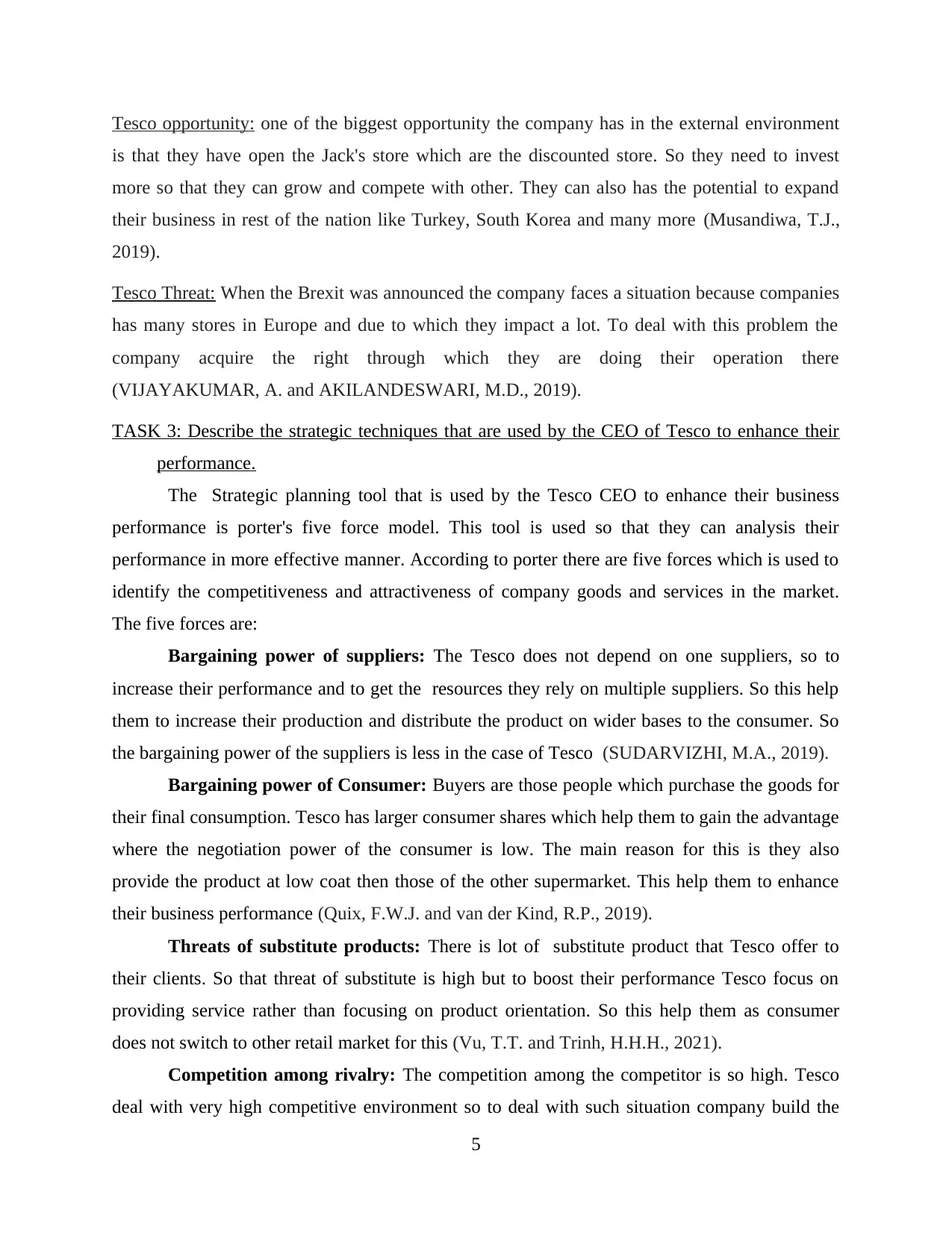
Tesco opportunity: one of the biggest opportunity the company has in the external environment
is that they have open the Jack's store which are the discounted store. So they need to invest
more so that they can grow and compete with other. They can also has the potential to expand
their business in rest of the nation like Turkey, South Korea and many more (Musandiwa, T.J.,
2019).
Tesco Threat: When the Brexit was announced the company faces a situation because companies
has many stores in Europe and due to which they impact a lot. To deal with this problem the
company acquire the right through which they are doing their operation there
(VIJAYAKUMAR, A. and AKILANDESWARI, M.D., 2019).
TASK 3: Describe the strategic techniques that are used by the CEO of Tesco to enhance their
performance.
The Strategic planning tool that is used by the Tesco CEO to enhance their business
performance is porter's five force model. This tool is used so that they can analysis their
performance in more effective manner. According to porter there are five forces which is used to
identify the competitiveness and attractiveness of company goods and services in the market.
The five forces are:
Bargaining power of suppliers: The Tesco does not depend on one suppliers, so to
increase their performance and to get the resources they rely on multiple suppliers. So this help
them to increase their production and distribute the product on wider bases to the consumer. So
the bargaining power of the suppliers is less in the case of Tesco (SUDARVIZHI, M.A., 2019).
Bargaining power of Consumer: Buyers are those people which purchase the goods for
their final consumption. Tesco has larger consumer shares which help them to gain the advantage
where the negotiation power of the consumer is low. The main reason for this is they also
provide the product at low coat then those of the other supermarket. This help them to enhance
their business performance (Quix, F.W.J. and van der Kind, R.P., 2019).
Threats of substitute products: There is lot of substitute product that Tesco offer to
their clients. So that threat of substitute is high but to boost their performance Tesco focus on
providing service rather than focusing on product orientation. So this help them as consumer
does not switch to other retail market for this (Vu, T.T. and Trinh, H.H.H., 2021).
Competition among rivalry: The competition among the competitor is so high. Tesco
deal with very high competitive environment so to deal with such situation company build the
5
is that they have open the Jack's store which are the discounted store. So they need to invest
more so that they can grow and compete with other. They can also has the potential to expand
their business in rest of the nation like Turkey, South Korea and many more (Musandiwa, T.J.,
2019).
Tesco Threat: When the Brexit was announced the company faces a situation because companies
has many stores in Europe and due to which they impact a lot. To deal with this problem the
company acquire the right through which they are doing their operation there
(VIJAYAKUMAR, A. and AKILANDESWARI, M.D., 2019).
TASK 3: Describe the strategic techniques that are used by the CEO of Tesco to enhance their
performance.
The Strategic planning tool that is used by the Tesco CEO to enhance their business
performance is porter's five force model. This tool is used so that they can analysis their
performance in more effective manner. According to porter there are five forces which is used to
identify the competitiveness and attractiveness of company goods and services in the market.
The five forces are:
Bargaining power of suppliers: The Tesco does not depend on one suppliers, so to
increase their performance and to get the resources they rely on multiple suppliers. So this help
them to increase their production and distribute the product on wider bases to the consumer. So
the bargaining power of the suppliers is less in the case of Tesco (SUDARVIZHI, M.A., 2019).
Bargaining power of Consumer: Buyers are those people which purchase the goods for
their final consumption. Tesco has larger consumer shares which help them to gain the advantage
where the negotiation power of the consumer is low. The main reason for this is they also
provide the product at low coat then those of the other supermarket. This help them to enhance
their business performance (Quix, F.W.J. and van der Kind, R.P., 2019).
Threats of substitute products: There is lot of substitute product that Tesco offer to
their clients. So that threat of substitute is high but to boost their performance Tesco focus on
providing service rather than focusing on product orientation. So this help them as consumer
does not switch to other retail market for this (Vu, T.T. and Trinh, H.H.H., 2021).
Competition among rivalry: The competition among the competitor is so high. Tesco
deal with very high competitive environment so to deal with such situation company build the
5
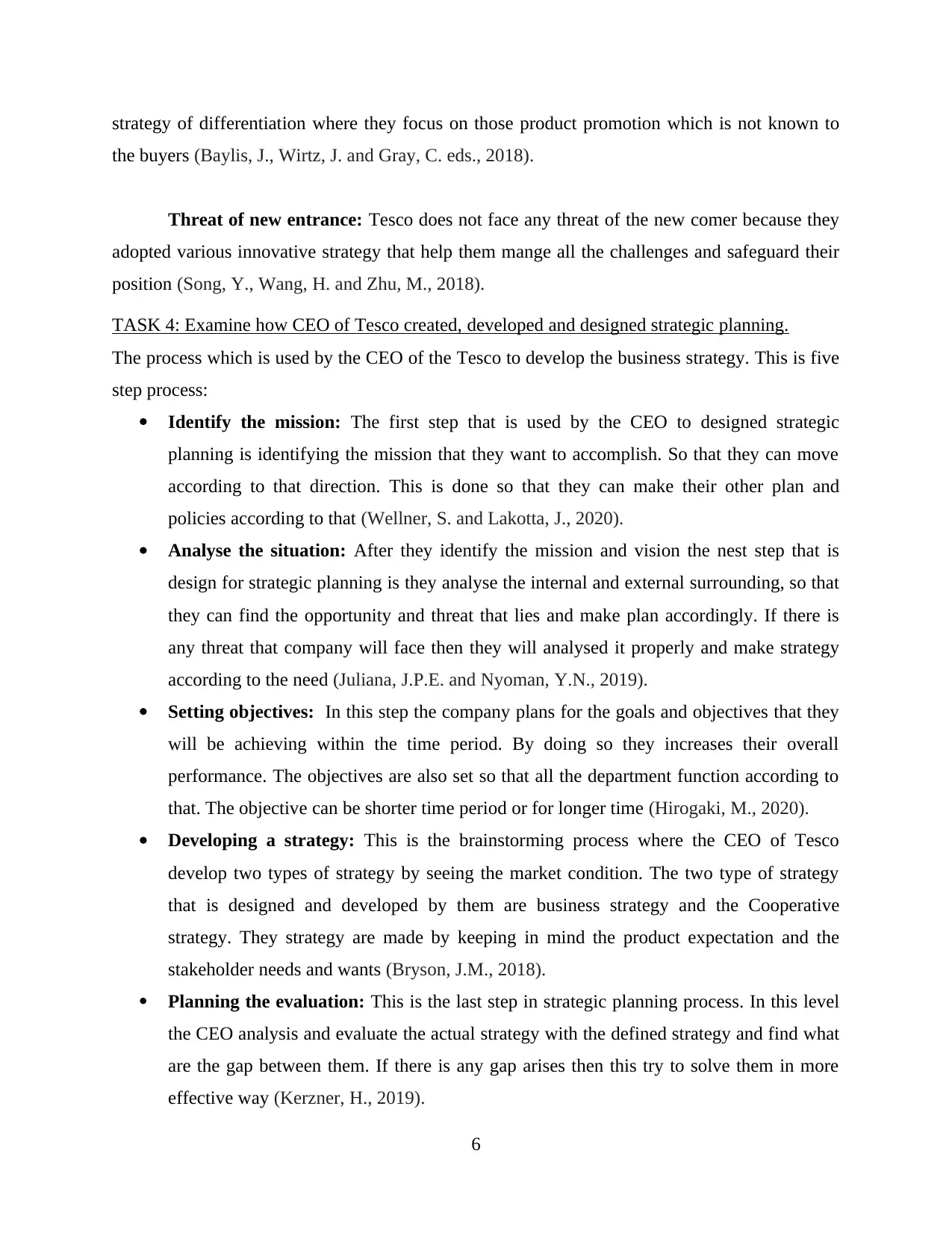
strategy of differentiation where they focus on those product promotion which is not known to
the buyers (Baylis, J., Wirtz, J. and Gray, C. eds., 2018).
Threat of new entrance: Tesco does not face any threat of the new comer because they
adopted various innovative strategy that help them mange all the challenges and safeguard their
position (Song, Y., Wang, H. and Zhu, M., 2018).
TASK 4: Examine how CEO of Tesco created, developed and designed strategic planning.
The process which is used by the CEO of the Tesco to develop the business strategy. This is five
step process:
Identify the mission: The first step that is used by the CEO to designed strategic
planning is identifying the mission that they want to accomplish. So that they can move
according to that direction. This is done so that they can make their other plan and
policies according to that (Wellner, S. and Lakotta, J., 2020).
Analyse the situation: After they identify the mission and vision the nest step that is
design for strategic planning is they analyse the internal and external surrounding, so that
they can find the opportunity and threat that lies and make plan accordingly. If there is
any threat that company will face then they will analysed it properly and make strategy
according to the need (Juliana, J.P.E. and Nyoman, Y.N., 2019).
Setting objectives: In this step the company plans for the goals and objectives that they
will be achieving within the time period. By doing so they increases their overall
performance. The objectives are also set so that all the department function according to
that. The objective can be shorter time period or for longer time (Hirogaki, M., 2020).
Developing a strategy: This is the brainstorming process where the CEO of Tesco
develop two types of strategy by seeing the market condition. The two type of strategy
that is designed and developed by them are business strategy and the Cooperative
strategy. They strategy are made by keeping in mind the product expectation and the
stakeholder needs and wants (Bryson, J.M., 2018).
Planning the evaluation: This is the last step in strategic planning process. In this level
the CEO analysis and evaluate the actual strategy with the defined strategy and find what
are the gap between them. If there is any gap arises then this try to solve them in more
effective way (Kerzner, H., 2019).
6
the buyers (Baylis, J., Wirtz, J. and Gray, C. eds., 2018).
Threat of new entrance: Tesco does not face any threat of the new comer because they
adopted various innovative strategy that help them mange all the challenges and safeguard their
position (Song, Y., Wang, H. and Zhu, M., 2018).
TASK 4: Examine how CEO of Tesco created, developed and designed strategic planning.
The process which is used by the CEO of the Tesco to develop the business strategy. This is five
step process:
Identify the mission: The first step that is used by the CEO to designed strategic
planning is identifying the mission that they want to accomplish. So that they can move
according to that direction. This is done so that they can make their other plan and
policies according to that (Wellner, S. and Lakotta, J., 2020).
Analyse the situation: After they identify the mission and vision the nest step that is
design for strategic planning is they analyse the internal and external surrounding, so that
they can find the opportunity and threat that lies and make plan accordingly. If there is
any threat that company will face then they will analysed it properly and make strategy
according to the need (Juliana, J.P.E. and Nyoman, Y.N., 2019).
Setting objectives: In this step the company plans for the goals and objectives that they
will be achieving within the time period. By doing so they increases their overall
performance. The objectives are also set so that all the department function according to
that. The objective can be shorter time period or for longer time (Hirogaki, M., 2020).
Developing a strategy: This is the brainstorming process where the CEO of Tesco
develop two types of strategy by seeing the market condition. The two type of strategy
that is designed and developed by them are business strategy and the Cooperative
strategy. They strategy are made by keeping in mind the product expectation and the
stakeholder needs and wants (Bryson, J.M., 2018).
Planning the evaluation: This is the last step in strategic planning process. In this level
the CEO analysis and evaluate the actual strategy with the defined strategy and find what
are the gap between them. If there is any gap arises then this try to solve them in more
effective way (Kerzner, H., 2019).
6
⊘ This is a preview!⊘
Do you want full access?
Subscribe today to unlock all pages.

Trusted by 1+ million students worldwide
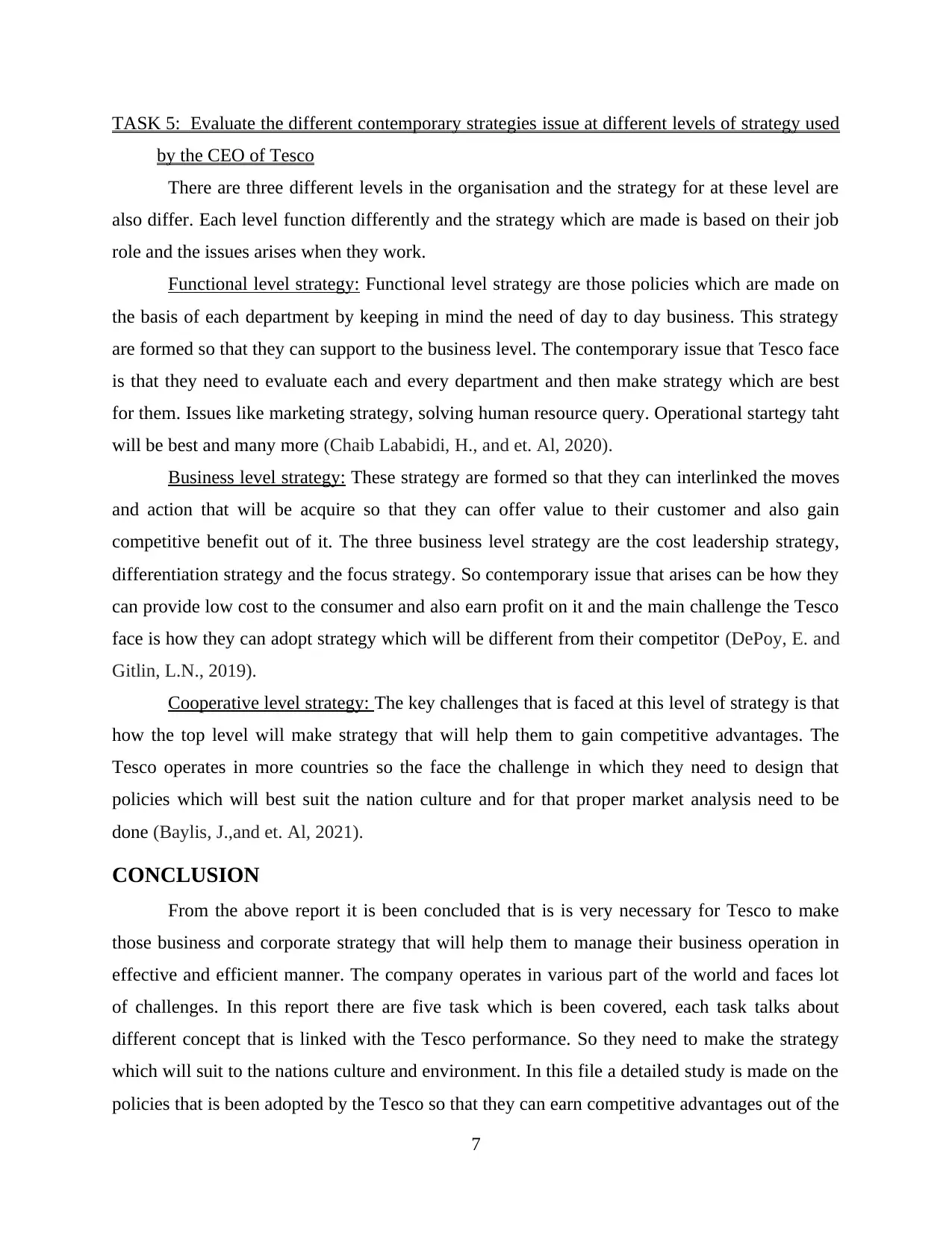
TASK 5: Evaluate the different contemporary strategies issue at different levels of strategy used
by the CEO of Tesco
There are three different levels in the organisation and the strategy for at these level are
also differ. Each level function differently and the strategy which are made is based on their job
role and the issues arises when they work.
Functional level strategy: Functional level strategy are those policies which are made on
the basis of each department by keeping in mind the need of day to day business. This strategy
are formed so that they can support to the business level. The contemporary issue that Tesco face
is that they need to evaluate each and every department and then make strategy which are best
for them. Issues like marketing strategy, solving human resource query. Operational startegy taht
will be best and many more (Chaib Lababidi, H., and et. Al, 2020).
Business level strategy: These strategy are formed so that they can interlinked the moves
and action that will be acquire so that they can offer value to their customer and also gain
competitive benefit out of it. The three business level strategy are the cost leadership strategy,
differentiation strategy and the focus strategy. So contemporary issue that arises can be how they
can provide low cost to the consumer and also earn profit on it and the main challenge the Tesco
face is how they can adopt strategy which will be different from their competitor (DePoy, E. and
Gitlin, L.N., 2019).
Cooperative level strategy: The key challenges that is faced at this level of strategy is that
how the top level will make strategy that will help them to gain competitive advantages. The
Tesco operates in more countries so the face the challenge in which they need to design that
policies which will best suit the nation culture and for that proper market analysis need to be
done (Baylis, J.,and et. Al, 2021).
CONCLUSION
From the above report it is been concluded that is is very necessary for Tesco to make
those business and corporate strategy that will help them to manage their business operation in
effective and efficient manner. The company operates in various part of the world and faces lot
of challenges. In this report there are five task which is been covered, each task talks about
different concept that is linked with the Tesco performance. So they need to make the strategy
which will suit to the nations culture and environment. In this file a detailed study is made on the
policies that is been adopted by the Tesco so that they can earn competitive advantages out of the
7
by the CEO of Tesco
There are three different levels in the organisation and the strategy for at these level are
also differ. Each level function differently and the strategy which are made is based on their job
role and the issues arises when they work.
Functional level strategy: Functional level strategy are those policies which are made on
the basis of each department by keeping in mind the need of day to day business. This strategy
are formed so that they can support to the business level. The contemporary issue that Tesco face
is that they need to evaluate each and every department and then make strategy which are best
for them. Issues like marketing strategy, solving human resource query. Operational startegy taht
will be best and many more (Chaib Lababidi, H., and et. Al, 2020).
Business level strategy: These strategy are formed so that they can interlinked the moves
and action that will be acquire so that they can offer value to their customer and also gain
competitive benefit out of it. The three business level strategy are the cost leadership strategy,
differentiation strategy and the focus strategy. So contemporary issue that arises can be how they
can provide low cost to the consumer and also earn profit on it and the main challenge the Tesco
face is how they can adopt strategy which will be different from their competitor (DePoy, E. and
Gitlin, L.N., 2019).
Cooperative level strategy: The key challenges that is faced at this level of strategy is that
how the top level will make strategy that will help them to gain competitive advantages. The
Tesco operates in more countries so the face the challenge in which they need to design that
policies which will best suit the nation culture and for that proper market analysis need to be
done (Baylis, J.,and et. Al, 2021).
CONCLUSION
From the above report it is been concluded that is is very necessary for Tesco to make
those business and corporate strategy that will help them to manage their business operation in
effective and efficient manner. The company operates in various part of the world and faces lot
of challenges. In this report there are five task which is been covered, each task talks about
different concept that is linked with the Tesco performance. So they need to make the strategy
which will suit to the nations culture and environment. In this file a detailed study is made on the
policies that is been adopted by the Tesco so that they can earn competitive advantages out of the
7
Paraphrase This Document
Need a fresh take? Get an instant paraphrase of this document with our AI Paraphraser
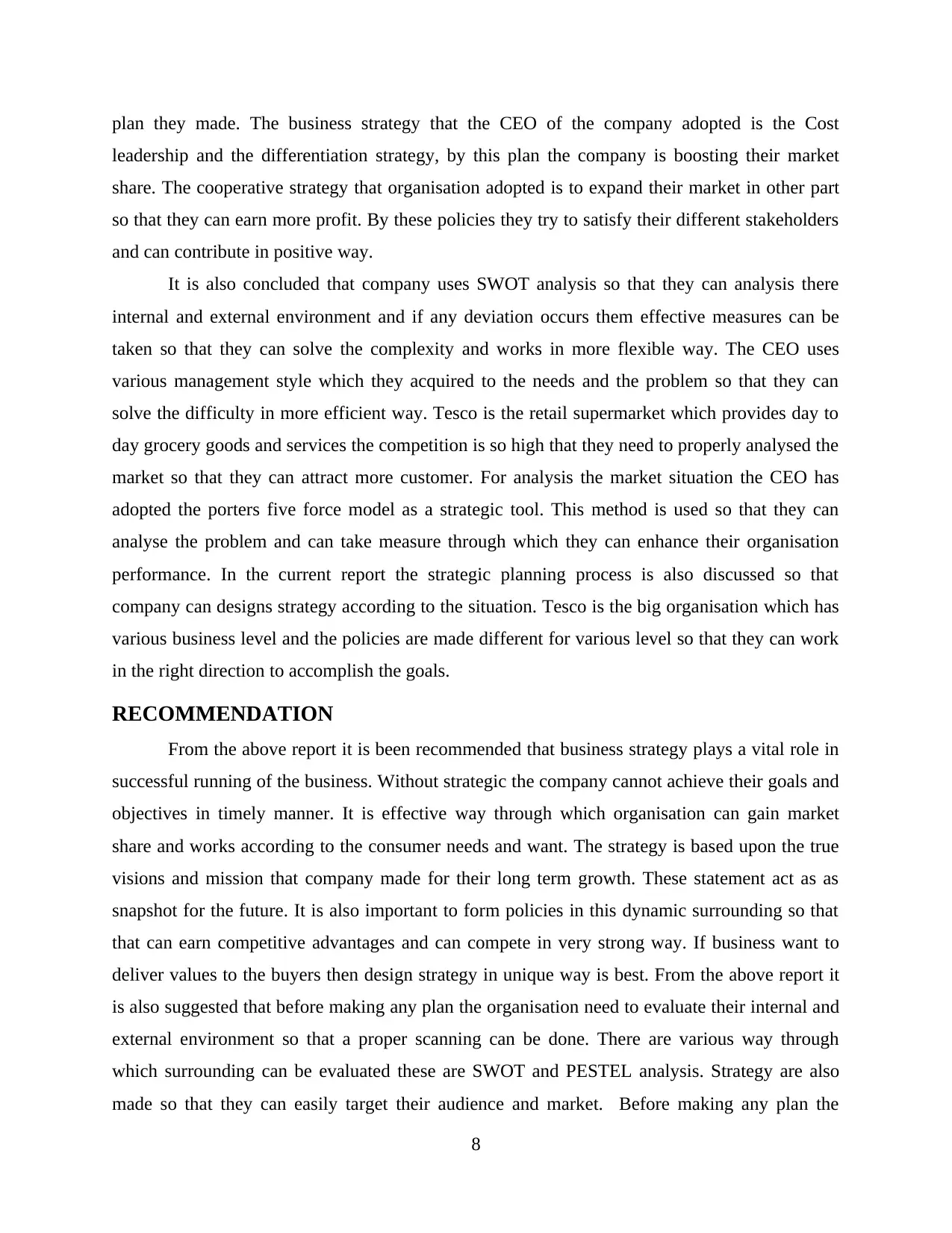
plan they made. The business strategy that the CEO of the company adopted is the Cost
leadership and the differentiation strategy, by this plan the company is boosting their market
share. The cooperative strategy that organisation adopted is to expand their market in other part
so that they can earn more profit. By these policies they try to satisfy their different stakeholders
and can contribute in positive way.
It is also concluded that company uses SWOT analysis so that they can analysis there
internal and external environment and if any deviation occurs them effective measures can be
taken so that they can solve the complexity and works in more flexible way. The CEO uses
various management style which they acquired to the needs and the problem so that they can
solve the difficulty in more efficient way. Tesco is the retail supermarket which provides day to
day grocery goods and services the competition is so high that they need to properly analysed the
market so that they can attract more customer. For analysis the market situation the CEO has
adopted the porters five force model as a strategic tool. This method is used so that they can
analyse the problem and can take measure through which they can enhance their organisation
performance. In the current report the strategic planning process is also discussed so that
company can designs strategy according to the situation. Tesco is the big organisation which has
various business level and the policies are made different for various level so that they can work
in the right direction to accomplish the goals.
RECOMMENDATION
From the above report it is been recommended that business strategy plays a vital role in
successful running of the business. Without strategic the company cannot achieve their goals and
objectives in timely manner. It is effective way through which organisation can gain market
share and works according to the consumer needs and want. The strategy is based upon the true
visions and mission that company made for their long term growth. These statement act as as
snapshot for the future. It is also important to form policies in this dynamic surrounding so that
that can earn competitive advantages and can compete in very strong way. If business want to
deliver values to the buyers then design strategy in unique way is best. From the above report it
is also suggested that before making any plan the organisation need to evaluate their internal and
external environment so that a proper scanning can be done. There are various way through
which surrounding can be evaluated these are SWOT and PESTEL analysis. Strategy are also
made so that they can easily target their audience and market. Before making any plan the
8
leadership and the differentiation strategy, by this plan the company is boosting their market
share. The cooperative strategy that organisation adopted is to expand their market in other part
so that they can earn more profit. By these policies they try to satisfy their different stakeholders
and can contribute in positive way.
It is also concluded that company uses SWOT analysis so that they can analysis there
internal and external environment and if any deviation occurs them effective measures can be
taken so that they can solve the complexity and works in more flexible way. The CEO uses
various management style which they acquired to the needs and the problem so that they can
solve the difficulty in more efficient way. Tesco is the retail supermarket which provides day to
day grocery goods and services the competition is so high that they need to properly analysed the
market so that they can attract more customer. For analysis the market situation the CEO has
adopted the porters five force model as a strategic tool. This method is used so that they can
analyse the problem and can take measure through which they can enhance their organisation
performance. In the current report the strategic planning process is also discussed so that
company can designs strategy according to the situation. Tesco is the big organisation which has
various business level and the policies are made different for various level so that they can work
in the right direction to accomplish the goals.
RECOMMENDATION
From the above report it is been recommended that business strategy plays a vital role in
successful running of the business. Without strategic the company cannot achieve their goals and
objectives in timely manner. It is effective way through which organisation can gain market
share and works according to the consumer needs and want. The strategy is based upon the true
visions and mission that company made for their long term growth. These statement act as as
snapshot for the future. It is also important to form policies in this dynamic surrounding so that
that can earn competitive advantages and can compete in very strong way. If business want to
deliver values to the buyers then design strategy in unique way is best. From the above report it
is also suggested that before making any plan the organisation need to evaluate their internal and
external environment so that a proper scanning can be done. There are various way through
which surrounding can be evaluated these are SWOT and PESTEL analysis. Strategy are also
made so that they can easily target their audience and market. Before making any plan the
8
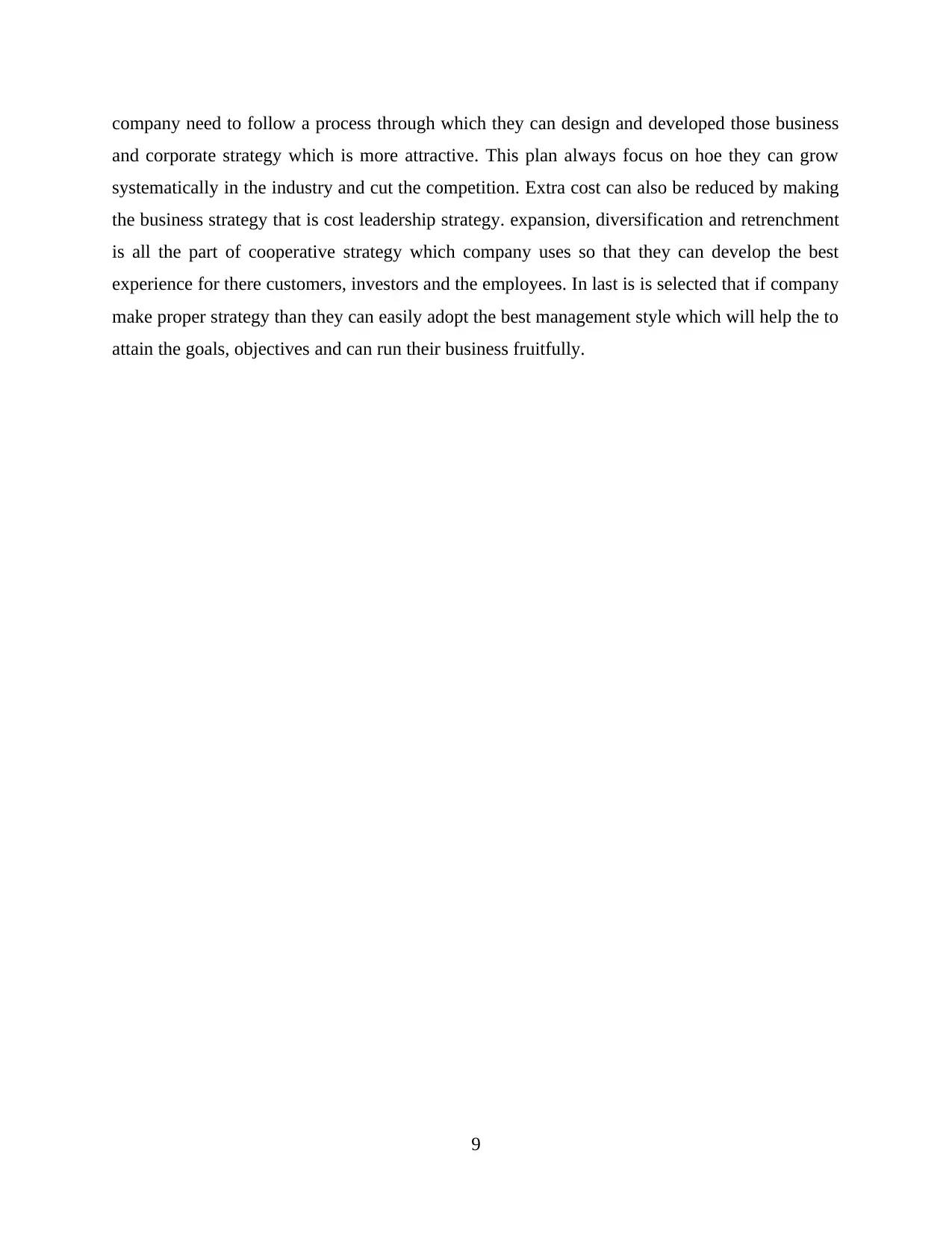
company need to follow a process through which they can design and developed those business
and corporate strategy which is more attractive. This plan always focus on hoe they can grow
systematically in the industry and cut the competition. Extra cost can also be reduced by making
the business strategy that is cost leadership strategy. expansion, diversification and retrenchment
is all the part of cooperative strategy which company uses so that they can develop the best
experience for there customers, investors and the employees. In last is is selected that if company
make proper strategy than they can easily adopt the best management style which will help the to
attain the goals, objectives and can run their business fruitfully.
9
and corporate strategy which is more attractive. This plan always focus on hoe they can grow
systematically in the industry and cut the competition. Extra cost can also be reduced by making
the business strategy that is cost leadership strategy. expansion, diversification and retrenchment
is all the part of cooperative strategy which company uses so that they can develop the best
experience for there customers, investors and the employees. In last is is selected that if company
make proper strategy than they can easily adopt the best management style which will help the to
attain the goals, objectives and can run their business fruitfully.
9
⊘ This is a preview!⊘
Do you want full access?
Subscribe today to unlock all pages.

Trusted by 1+ million students worldwide
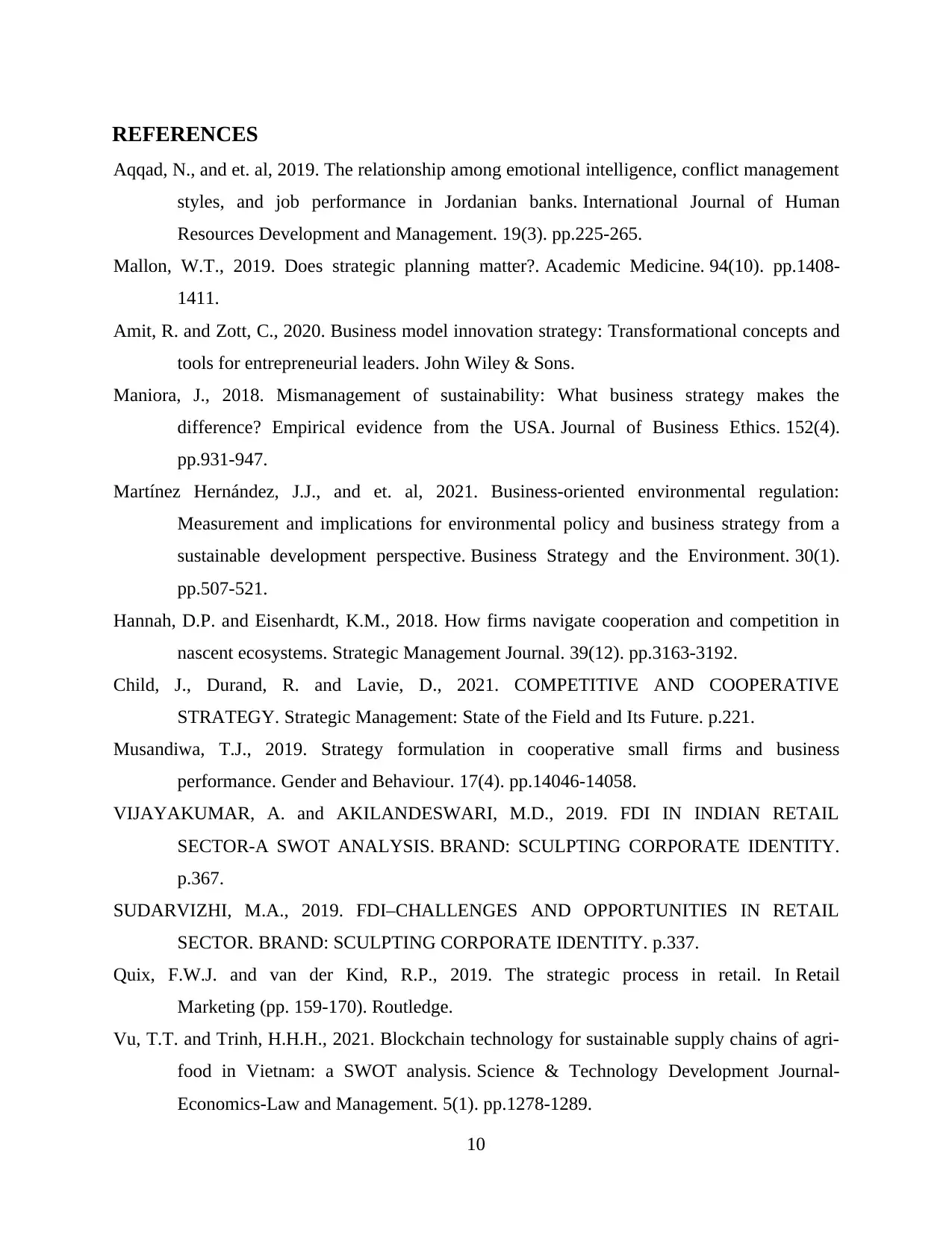
REFERENCES
Aqqad, N., and et. al, 2019. The relationship among emotional intelligence, conflict management
styles, and job performance in Jordanian banks. International Journal of Human
Resources Development and Management. 19(3). pp.225-265.
Mallon, W.T., 2019. Does strategic planning matter?. Academic Medicine. 94(10). pp.1408-
1411.
Amit, R. and Zott, C., 2020. Business model innovation strategy: Transformational concepts and
tools for entrepreneurial leaders. John Wiley & Sons.
Maniora, J., 2018. Mismanagement of sustainability: What business strategy makes the
difference? Empirical evidence from the USA. Journal of Business Ethics. 152(4).
pp.931-947.
Martínez Hernández, J.J., and et. al, 2021. Business‐oriented environmental regulation:
Measurement and implications for environmental policy and business strategy from a
sustainable development perspective. Business Strategy and the Environment. 30(1).
pp.507-521.
Hannah, D.P. and Eisenhardt, K.M., 2018. How firms navigate cooperation and competition in
nascent ecosystems. Strategic Management Journal. 39(12). pp.3163-3192.
Child, J., Durand, R. and Lavie, D., 2021. COMPETITIVE AND COOPERATIVE
STRATEGY. Strategic Management: State of the Field and Its Future. p.221.
Musandiwa, T.J., 2019. Strategy formulation in cooperative small firms and business
performance. Gender and Behaviour. 17(4). pp.14046-14058.
VIJAYAKUMAR, A. and AKILANDESWARI, M.D., 2019. FDI IN INDIAN RETAIL
SECTOR-A SWOT ANALYSIS. BRAND: SCULPTING CORPORATE IDENTITY.
p.367.
SUDARVIZHI, M.A., 2019. FDI–CHALLENGES AND OPPORTUNITIES IN RETAIL
SECTOR. BRAND: SCULPTING CORPORATE IDENTITY. p.337.
Quix, F.W.J. and van der Kind, R.P., 2019. The strategic process in retail. In Retail
Marketing (pp. 159-170). Routledge.
Vu, T.T. and Trinh, H.H.H., 2021. Blockchain technology for sustainable supply chains of agri-
food in Vietnam: a SWOT analysis. Science & Technology Development Journal-
Economics-Law and Management. 5(1). pp.1278-1289.
10
Aqqad, N., and et. al, 2019. The relationship among emotional intelligence, conflict management
styles, and job performance in Jordanian banks. International Journal of Human
Resources Development and Management. 19(3). pp.225-265.
Mallon, W.T., 2019. Does strategic planning matter?. Academic Medicine. 94(10). pp.1408-
1411.
Amit, R. and Zott, C., 2020. Business model innovation strategy: Transformational concepts and
tools for entrepreneurial leaders. John Wiley & Sons.
Maniora, J., 2018. Mismanagement of sustainability: What business strategy makes the
difference? Empirical evidence from the USA. Journal of Business Ethics. 152(4).
pp.931-947.
Martínez Hernández, J.J., and et. al, 2021. Business‐oriented environmental regulation:
Measurement and implications for environmental policy and business strategy from a
sustainable development perspective. Business Strategy and the Environment. 30(1).
pp.507-521.
Hannah, D.P. and Eisenhardt, K.M., 2018. How firms navigate cooperation and competition in
nascent ecosystems. Strategic Management Journal. 39(12). pp.3163-3192.
Child, J., Durand, R. and Lavie, D., 2021. COMPETITIVE AND COOPERATIVE
STRATEGY. Strategic Management: State of the Field and Its Future. p.221.
Musandiwa, T.J., 2019. Strategy formulation in cooperative small firms and business
performance. Gender and Behaviour. 17(4). pp.14046-14058.
VIJAYAKUMAR, A. and AKILANDESWARI, M.D., 2019. FDI IN INDIAN RETAIL
SECTOR-A SWOT ANALYSIS. BRAND: SCULPTING CORPORATE IDENTITY.
p.367.
SUDARVIZHI, M.A., 2019. FDI–CHALLENGES AND OPPORTUNITIES IN RETAIL
SECTOR. BRAND: SCULPTING CORPORATE IDENTITY. p.337.
Quix, F.W.J. and van der Kind, R.P., 2019. The strategic process in retail. In Retail
Marketing (pp. 159-170). Routledge.
Vu, T.T. and Trinh, H.H.H., 2021. Blockchain technology for sustainable supply chains of agri-
food in Vietnam: a SWOT analysis. Science & Technology Development Journal-
Economics-Law and Management. 5(1). pp.1278-1289.
10
Paraphrase This Document
Need a fresh take? Get an instant paraphrase of this document with our AI Paraphraser
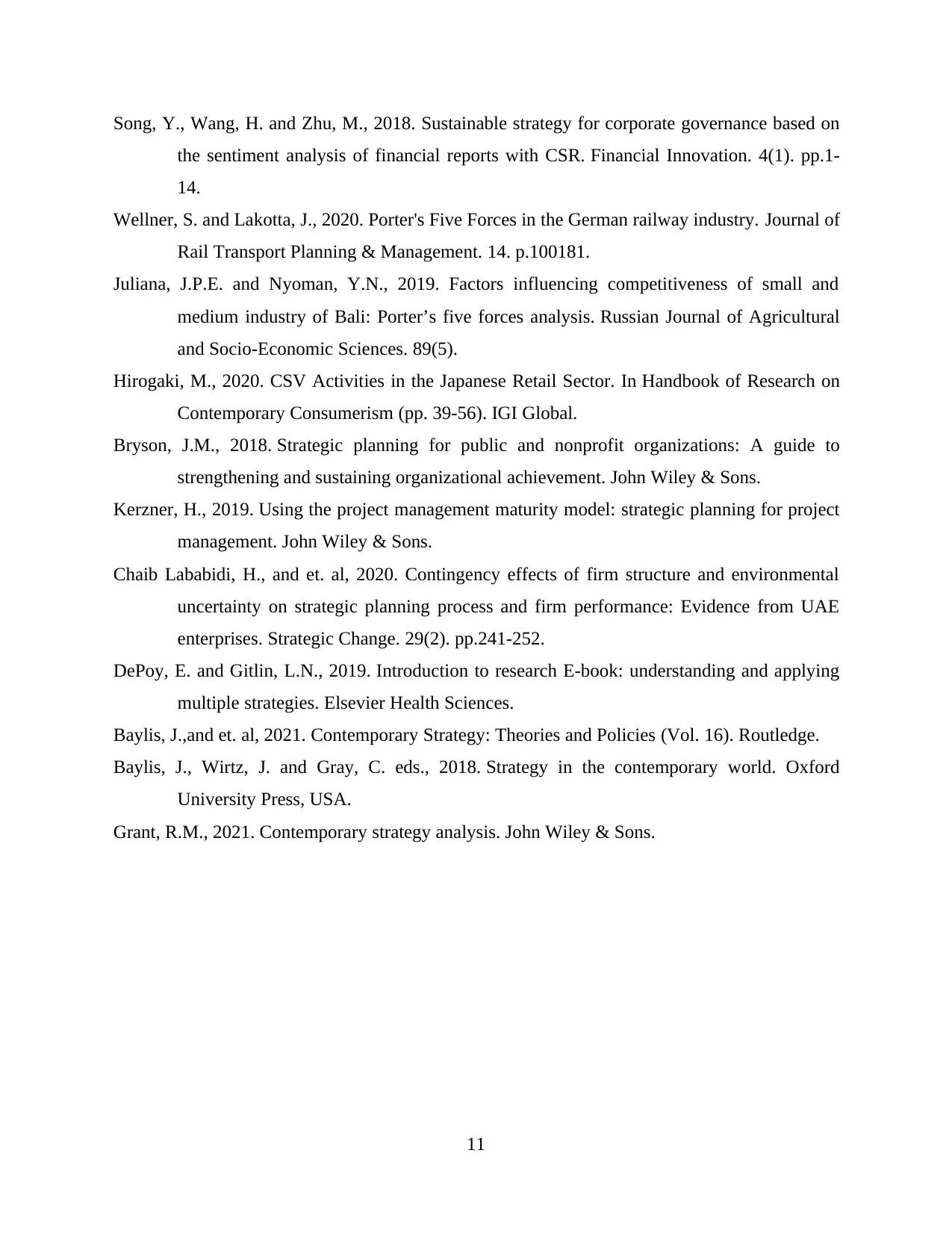
Song, Y., Wang, H. and Zhu, M., 2018. Sustainable strategy for corporate governance based on
the sentiment analysis of financial reports with CSR. Financial Innovation. 4(1). pp.1-
14.
Wellner, S. and Lakotta, J., 2020. Porter's Five Forces in the German railway industry. Journal of
Rail Transport Planning & Management. 14. p.100181.
Juliana, J.P.E. and Nyoman, Y.N., 2019. Factors influencing competitiveness of small and
medium industry of Bali: Porter’s five forces analysis. Russian Journal of Agricultural
and Socio-Economic Sciences. 89(5).
Hirogaki, M., 2020. CSV Activities in the Japanese Retail Sector. In Handbook of Research on
Contemporary Consumerism (pp. 39-56). IGI Global.
Bryson, J.M., 2018. Strategic planning for public and nonprofit organizations: A guide to
strengthening and sustaining organizational achievement. John Wiley & Sons.
Kerzner, H., 2019. Using the project management maturity model: strategic planning for project
management. John Wiley & Sons.
Chaib Lababidi, H., and et. al, 2020. Contingency effects of firm structure and environmental
uncertainty on strategic planning process and firm performance: Evidence from UAE
enterprises. Strategic Change. 29(2). pp.241-252.
DePoy, E. and Gitlin, L.N., 2019. Introduction to research E-book: understanding and applying
multiple strategies. Elsevier Health Sciences.
Baylis, J.,and et. al, 2021. Contemporary Strategy: Theories and Policies (Vol. 16). Routledge.
Baylis, J., Wirtz, J. and Gray, C. eds., 2018. Strategy in the contemporary world. Oxford
University Press, USA.
Grant, R.M., 2021. Contemporary strategy analysis. John Wiley & Sons.
11
the sentiment analysis of financial reports with CSR. Financial Innovation. 4(1). pp.1-
14.
Wellner, S. and Lakotta, J., 2020. Porter's Five Forces in the German railway industry. Journal of
Rail Transport Planning & Management. 14. p.100181.
Juliana, J.P.E. and Nyoman, Y.N., 2019. Factors influencing competitiveness of small and
medium industry of Bali: Porter’s five forces analysis. Russian Journal of Agricultural
and Socio-Economic Sciences. 89(5).
Hirogaki, M., 2020. CSV Activities in the Japanese Retail Sector. In Handbook of Research on
Contemporary Consumerism (pp. 39-56). IGI Global.
Bryson, J.M., 2018. Strategic planning for public and nonprofit organizations: A guide to
strengthening and sustaining organizational achievement. John Wiley & Sons.
Kerzner, H., 2019. Using the project management maturity model: strategic planning for project
management. John Wiley & Sons.
Chaib Lababidi, H., and et. al, 2020. Contingency effects of firm structure and environmental
uncertainty on strategic planning process and firm performance: Evidence from UAE
enterprises. Strategic Change. 29(2). pp.241-252.
DePoy, E. and Gitlin, L.N., 2019. Introduction to research E-book: understanding and applying
multiple strategies. Elsevier Health Sciences.
Baylis, J.,and et. al, 2021. Contemporary Strategy: Theories and Policies (Vol. 16). Routledge.
Baylis, J., Wirtz, J. and Gray, C. eds., 2018. Strategy in the contemporary world. Oxford
University Press, USA.
Grant, R.M., 2021. Contemporary strategy analysis. John Wiley & Sons.
11

12
⊘ This is a preview!⊘
Do you want full access?
Subscribe today to unlock all pages.

Trusted by 1+ million students worldwide
1 out of 12
Related Documents
Your All-in-One AI-Powered Toolkit for Academic Success.
+13062052269
info@desklib.com
Available 24*7 on WhatsApp / Email
![[object Object]](/_next/static/media/star-bottom.7253800d.svg)
Unlock your academic potential
Copyright © 2020–2025 A2Z Services. All Rights Reserved. Developed and managed by ZUCOL.


